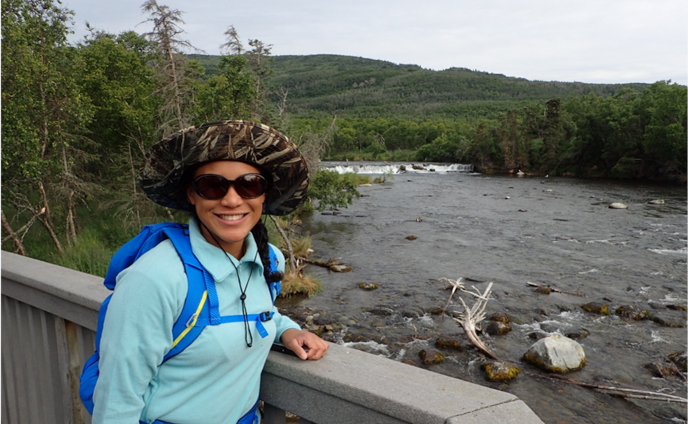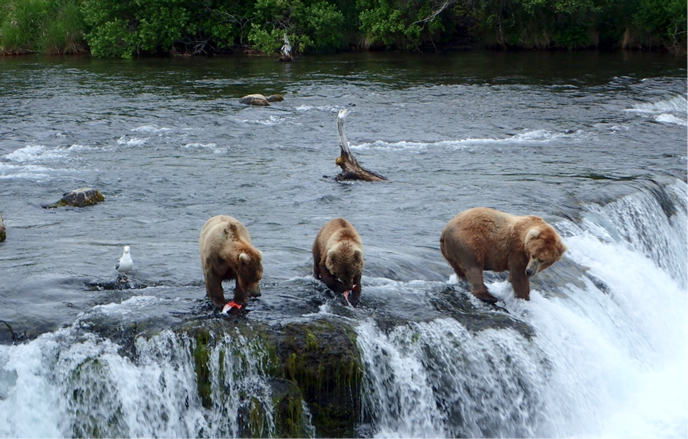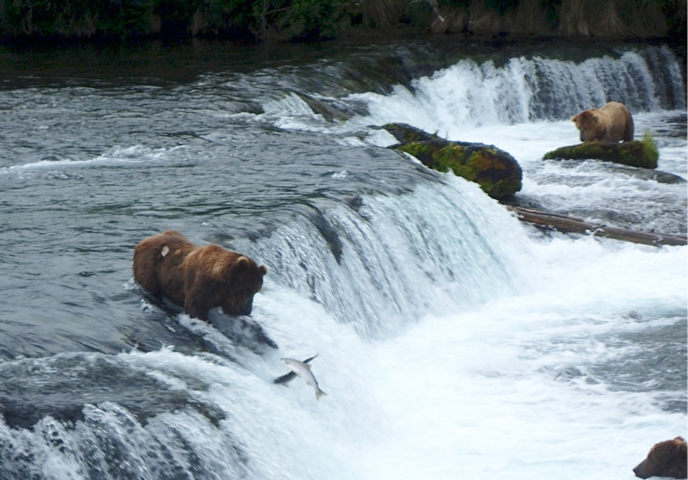 Tamija Woods is a high school graduate from Anchorage who will be attending the University of Alaska Anchorage in the fall. She was an Alaska Native Science and Engineering Program (ANSEP) intern at Katmai National Park this July. NPS photo.
Tamija Woods is a high school graduate from Anchorage who will be attending the University of Alaska Anchorage in the fall. She was an Alaska Native Science and Engineering Program (ANSEP) intern at Katmai National Park this July. NPS photo.
One of the highlights of my summer internship included observing bear behaviors at the Brooks River Falls, conducting historic sites surveys, and identifying and removing invasive plants. As a resident of Anchorage, I had never heard of Katmai or Brooks Camp before coming to King Salmon. I was unaware Katmai had volcanoes, or that invasive plants are affecting our national lands and spreading faster than a bear can run. Before arriving in King Salmon, I was a little nervous about going to Brooks Camp—what could be more nerve-racking than being surrounded by the world’s largest land predators? Will a ranger be with me 24/7 with a loaded weapon? Will I walk along a meadow trail full of hungry predators? What if the bear gets within 30 feet from the trail I’m on, will the ranger shoot the bear?
Once I arrived at Brooks Camp I learned it was nothing like I imagined. Brooks Camp is full of rangers but they are not my bodyguards. There are trails, but if a bear appears within 50 yards he has the right-of-way so I need to get off the trail. Interpretive rangers carry bear spray. A bear’s body language lets you know that they either don’t want you around, or that they don’t mind your presence. My first day at Brooks Camp I learned that I am in the wild—in bear territory. Contrary to popular myth, by no means do the bears have cages or a bed-time. The Falls area is not a waterpark. The rangers can’t turn off the water and stop the fish from swimming upstream. It is all real.
 Bears enjoying fresh-caught salmon at Brooks Falls. Watching bears in the wild was one of the internship’s highlights. NPS/T. Woods.
Bears enjoying fresh-caught salmon at Brooks Falls. Watching bears in the wild was one of the internship’s highlights. NPS/T. Woods.
There were several things that I wanted to see at Brooks Camp: a sow with four cubs, a pool of spawning salmon, a wolf, and a bear family. I saw a sow and four spring cubs behind the Lodge buildings, laying close to the trees. She was comfortable and didn’t want to move. Generally, when you run into a sow and her cubs it is a good idea to give them lots of room. I was too close—within 50 yards of the bear—only because it was next to the restroom and I didn’t see them! This happens a lot around the lodge.
While eradicating invasive plants from the Valley Road, I hoped to see a wolf for the first time, but wolves are very secretive and like to stay away from humans. I saw one red spawning salmon among many silver-colored salmon while walking the Bridge to the lower river platform. It was swimming upstream towards the falls. Last on my list was a whole bear family, but it had occurred to me that a bear family is only considered a sow and her cubs—the boar doesn’t stick around. I did see a dominant boar and a sow mate. For the rest of the day, that same boar had chased the sow around the falls and riffles area. Bear mating can be very aggressive!
As an ANSEP intern, I really feel fortunate to have had these experiences. I left Brooks Camp with a breadth of knowledge that I will share at a poster presentation in Anchorage. Not only that, but I am very fond of bears now. I found myself at the falls fascinated and watching for hours as bears tore off the fatty skin from the salmon or impatiently swatted the water to get the salmon. Katmai is a fun and safe place to be if you obey the rules. The next chance I get I’ll be sure to say hi to one of my favorite and most aggressive friends, bear 775.
 Bear 775 tries his paw at fishing the Brooks Falls. He became famous on Katmai’s bearcams when he repeatedly jumped off of Brooks Falls. NPS/T. Woods.
Bear 775 tries his paw at fishing the Brooks Falls. He became famous on Katmai’s bearcams when he repeatedly jumped off of Brooks Falls. NPS/T. Woods.
